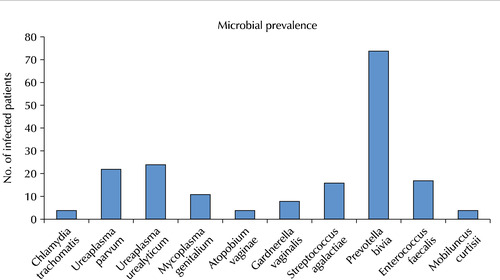Search
- Page Path
- HOME > Search
Original Article
- Impact of Microbial Infection on Sperm Parameters of Seminal Bacteria in Asymptomatic Subfertile Males
- Sae Byuk Chang, Tae Jin Kim, Tae Heon Kim, Seung-Ryeol Lee, Young Kwon Hong, Dong Soo Park, Sun-Mi Cho, Dong Hyeon Lee, Young Dong Yu
- Urogenit Tract Infect 2023;18(3):82-92. Published online December 31, 2023
- DOI: https://doi.org/10.14777/uti.2023.18.3.82

-
 Abstract
Abstract
 PDF
PDF PubReader
PubReader ePub
ePub - Purpose: This study examined the effects of asymptomatic bacteriospermia on the semen quality of subfertile males. The types of bacteria and their antibiotic susceptibility were also analyzed.
Materials and Methods: Semen was collected and analyzed from 510 subfertile males. One hundred and seventy-nine males showed bacteriospermia, while 331 males did not. The bacterial species, sperm parameters, hormone levels, underlying disease, and lifestyle patterns were compared between the two study groups.
Results: The bacteriospermic males showed significantly higher rates of leukocytospermia (p=0.001) and deoxyribonucleic acid (DNA) fragmentation than the non-bacteriospermic males. Sperm motility was significantly lower in the bacteriospermic males than in non-bacteriospermic males. The most common seminal bacterial species were Prevotella bivia (P. bivia, 41.3%) and Ureaplasma urealyticum (U. urealyticum, 13.4%). U. parvum showed the highest recurrence rates (31.8%) three months after the initial antibiotic treatment. Regarding the sperm parameters of bacteriospermic males, the sperm concentration, total motility, progressive motility, leukocytospermia, and DNA fragmentation were improved significantly after the initial antibiotics treatment. Multivariate logistic regression analyses revealed P. bivia, U. urealyticum, and U. parvum to be associated with the decreased motility and increased DNA fragmentation of spermatozoa. P. bivia was also associated with a decreased sperm concentration (p=0.002) and vitality (p=0.013).
Conclusions: Bacteriospermia decreased the sperm concentration, motility, normal morphology, and vitality. P. bivia is the most commonly observed bacteria in subfertile males. Appropriate antibiotic therapy of seminal bacteria species had a strong positive impact on improving the semen parameters.
- 6,114 View
- 33 Download

Review
- Prophylactic Antimicrobial Therapy and Antimicrobial Stewardship in Urologic Surgery
- Hee Jo Yang
- Urogenit Tract Infect 2023;18(1):8-14. Published online April 30, 2023
- DOI: https://doi.org/10.14777/uti.2023.18.1.8
-
 Abstract
Abstract
 PDF
PDF PubReader
PubReader ePub
ePub - Postoperative infectious complications are a worrying problem for surgeons. Urological surgery has a higher risk of postoperative urinary tract infection than other surgeries because of the common use of various types of catheters. Due to the recent increase in antibiotic resistance, antimicrobial stewardship recommends using appropriate antibiotics for a suitable period. It is generally advocated that prescribing antibiotics in the absence of infection is equivalent to the inappropriate use of antibiotics. Based on numerous studies reported by several academic societies, appropriate use of antibiotics before surgery has been suggested. It was confirmed that using antibiotics according to these guidelines reduces the use of antibiotics without increasing the incidence of postoperative infectious complications. Furthermore, endourological surgery reports have proved the efficacy of antibiotics given once before surgery. Differences in antibiotic resistance by region must be taken into consideration when selecting the appropriate antibiotic type.
- 6,229 View
- 76 Download


 KAUTII
KAUTII
 First
First Prev
Prev


